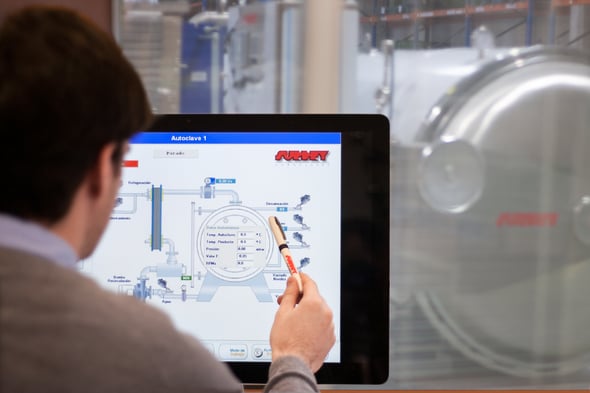Good maintenance is the best way to ensure food safety and avoid unexpected costs. Food and beverage sterilization equipment require simple maintenance, but proper maintenance is essential to prevent problems. This includes regular checks, cleaning, and control tests, which trained personnel must carry out.

Correct maintenance will bring many benefits, both in terms of process quality and equipment durability, so it is important to keep these aspects in mind:
Prioritize cleaning and preventive maintenance actions.
Preventive maintenance actions save a lot of problems, so it is essential to prioritize these tasks and integrate them into the day-to-day running of the production plant. In food and beverage sterilization facilities, it is crucial to carry out these actions to ensure that the retort works appropriately:
-
Cleaning of diffusers.
-
Cleaning of the recirculation suction grilles.
-
Cleaning the recirculation filter.
-
Cleaning of the heat exchanger.
-
Checking the pump impeller.
-
Cleaning of the water level system.
-
Tightening of the stuffing box.
-
Cleaning of the door gasket.
-
Checking the operation of the safety valves.
-
Checking of temperature and pressure measurements.
Checking the quality of utilities
Within the sterilization process, it is essential to achieve adequate heating and a uniform temperature inside the autoclave, with values adjusted to the recipe's requirements. These factors depend on the correct distribution of the utilities, mainly steam and water.
Therefore, in order to avoid deviations and process failures, maintenance actions must include quality checks concerning:
- The compressed air supply.
- The supply of steam.
- Water supply.
- Electrical supply.
It is also important to periodically examine the tension of the chain conveyor.
Check the temperature control instruments.
Temperature monitoring inside the retort is an indispensable element. For this purpose, the equipment is equipped with temperature control and recording instruments, which must always be adjusted to the reading of the standard thermometer.
The maintenance tasks necessary to ensure proper operation and, therefore, the correct sterilization of the product include two main aspects:
-
Checking the temperature sensors based on the standard thermometer. If there is a deviation of ± 0.5 ºC, it is obligatory to report the incident to the quality control manager.
-
Calibration of the standard thermometer. This instrument must be calibrated on the basis of a temperature standard of greater traceability, a control carried out externally in a specialized laboratory. As a general rule, the standard thermometer is calibrated once a year, but this may have to be done in shorter periods.
Use quality water for recirculation processes inside the autoclave.
Steam injection combined with water ensures correct temperature distribution and thus complete sterilization of the product. The water used in the recirculation process must be of high quality, with a composition low in calcium and magnesium salts.
The Spanish technical-sanitary regulation establishes a minimum total hardness of 150mg/l CaCO to indicate quality value for softened water.
Ensure that the maintenance team is well trained.
The technicians responsible for preventive maintenance must be previously trained in these tasks. In this way, the company will have greater autonomy and avoid problems linked to stoppages, failures, and accidents in the plant.
The manufacturer of the autoclave must provide adequate training, both on a theoretical level and on the machine itself so that the staff gains all the necessary knowledge.
Schedule the maintenance activities
The technical team in charge can best plan the most appropriate times to carry out maintenance actions according to the processes, the installation, and their own experience. Even so, these periodic actions can be used as a guide:
Daily:
- Temperature measurements with the standard thermometer.
Weekly:
- -Check pressure with the standard gauges.
- Inspection of the door, edges, lock, and safety lock device.
- Lubrication of motor surface and chain drive.
- Checking the condition of the chain conveyor and its position.
Monthly:
- Checking the adjustment of the valves
- Check of chain positioning and adjustment of detectors and chain if necessary.
- Checking the condition of the chain.
Annually:
- Sending the standard thermometer to a laboratory for calibration and certification.
- Check the roller conveyor and replace it if necessary.
- Check the correct functioning of the emergency mushrooms.
Every 3 years:
- Hydraulic test.
If necessary:
- Check the condition of the diffusers and replace if necessary.
- Replacement of the mechanical seal of the recirculation pump in case of leakage.
- Replacement of the door seal in case of cracks or wear.
Apply real-time control technologies.
Connectivity applied to autoclaves brings numerous advantages, also in the field of maintenance. In autoclaves equipped with automatic treatment cycle control, it is possible to control deviations, record operations, and monitor energy consumption. In this way, problems or inefficiencies will be detected early, and it will be easier to implement actions to improve performance.
Proper installation control and regular preventive maintenance, carried out by trained and authorized technicians, are the keys to getting the most out of sterilization equipment. If carried out correctly, we will obtain very significant cost savings in exchange for a small effort.


